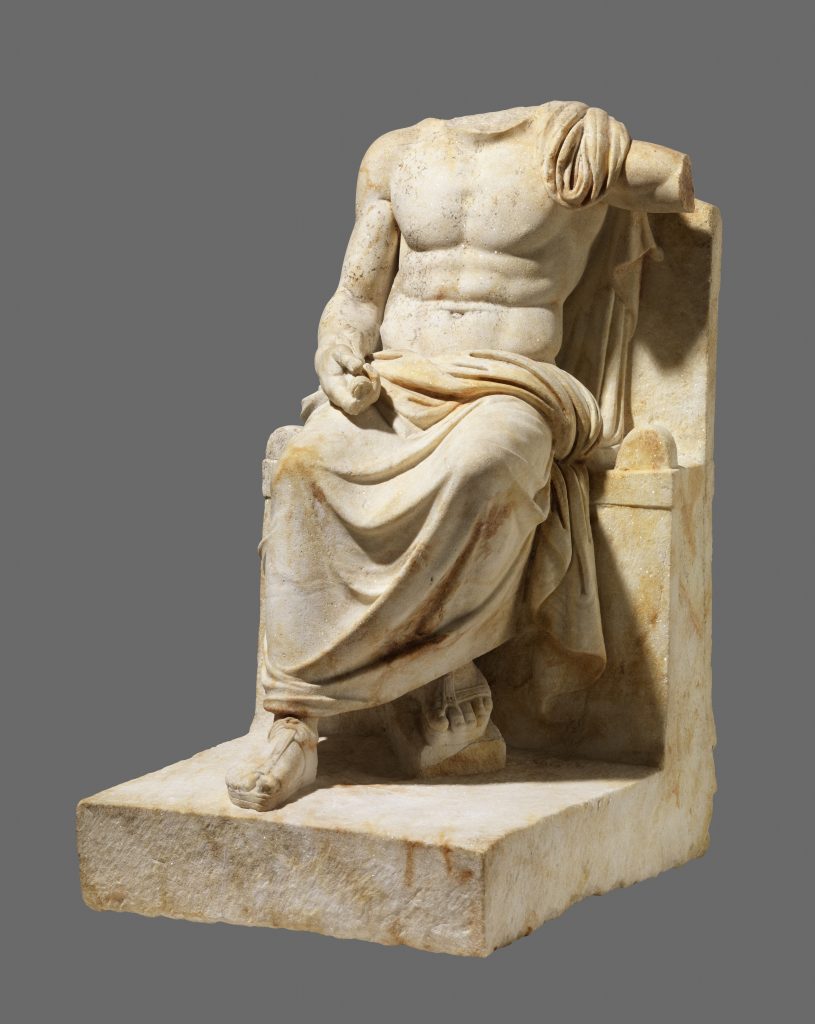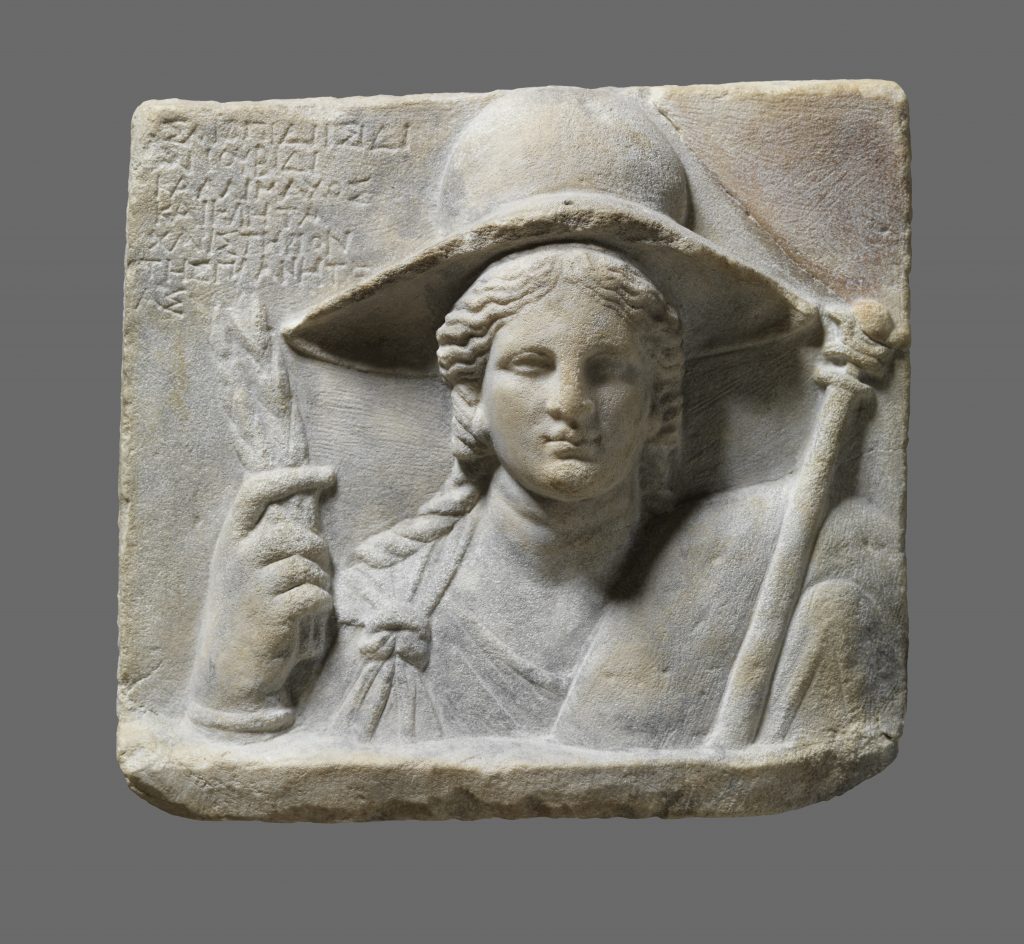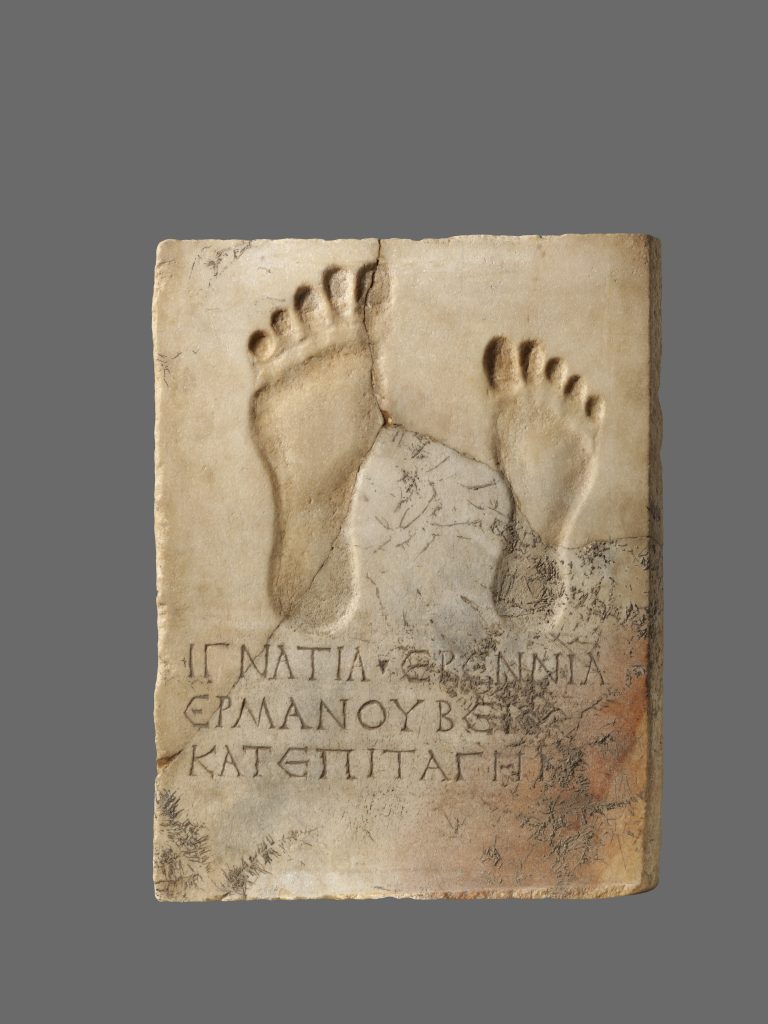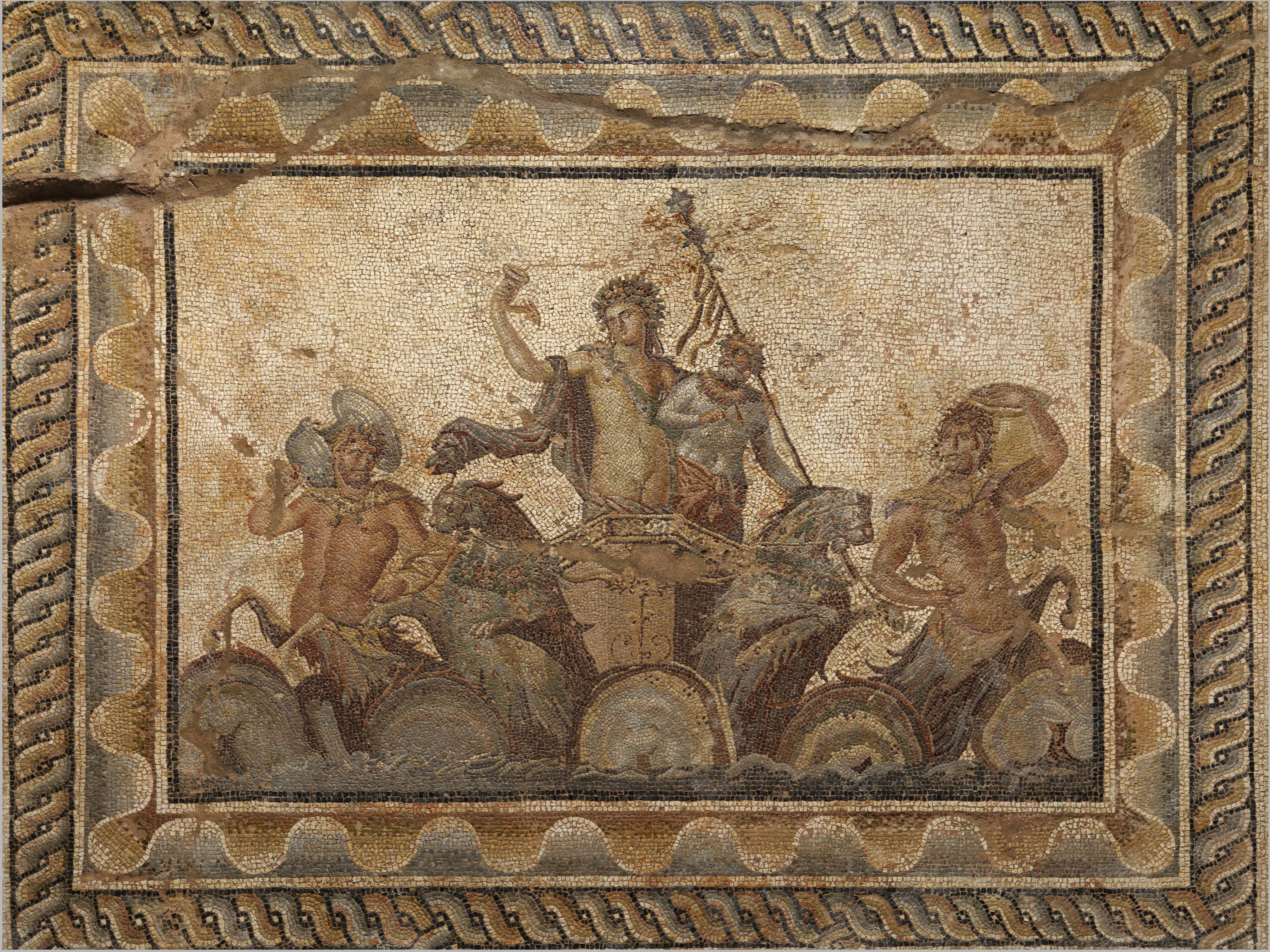Enjoying a privileged and bucolic position on the eastern slopes of Mount Olympus, the ancient Greek city of Dion prospered for thousands of years as a sacred center for the cult of Zeus and as the gateway to Macedonia. Gods and Mortals at Olympus: Ancient Dion, City of Zeus, now on show at the Onassis Cultural Center in New York, N.Y., examines the development and trajectory of Dion, from a small rural settlement to a thriving Roman colony, through the presentation of remarkable archaeological artifacts not seen outside of Greece.

Cult Statue of Zeus Hypsistos 2nd century AD. Marble. H. 33.7 in; W. 18.1 in; D. 25 in (H. 85.5 cm; W. 46 cm; D. 63.5 cm). From Dion. Sanctuary of Zeus Hypsistos, Cella. Archaeological Museum of Dion. Photo © Hellenic Ministry of Culture and Sports, Ephorate of Antiquities of Pieria, and the Dion Excavations. Courtesy Onassis Cultural Center NY.
In this exclusive interview, James Blake Wiener of Ancient History Encyclopedia speaks to Dr. Dimitrios Pandermalis about this exhibition and Dion’s importance in the wider Greco-Roman world.
JW: Dr. Dimitrios Pandermalis, I bid you a warm welcome to Ancient History Encyclopedia (AHE), and I thank you for speaking with me about Gods and Mortals at Olympus: Ancient Dion, City of Zeus.
You have been the director of the excavations at the ancient city of Dion since 1973, and you know the site intimately. Keeping this in mind, could you explain what it is that makes Dion “special” even “exceptional” compared to other archaeological sites in Greece?
DP: Although there were other cities of the same name in antiquity, Dion, located in northern Greece, was unique not only because it was a sacred site to Zeus, but also because it was the sanctuary in most immediate proximity to Mt. Olympus – the home of the ancient Greek gods. In addition, the site came into being because it was the point at which hundreds of fresh water springs — flowing from the holy peaks of Mt. Olympus — emerged at ground level.

Relief Stele Depicting Isis as Demeter with Dedicatory Inscription. Second half of 3rd–early 2nd century BC. Marble. H. 12.2 in; W. 13.4 in; D. 3.1 in (H. 31 cm; W. 34 cm; D. 8 cm). From Dion. Sanctuary of Isis, Courtyard of the temple of Isis Lochia. Archaeological Museum of Dion. Photo © Hellenic Ministry of Culture and Sports, Ephorate of Antiquities of Pieria, and the Dion Excavations. Courtesy Onassis Cultural Center NY.
JW: If I am not mistaken, Dion maintained deep ties to the kingdom of Macedonia and was favored by Macedonian royalty. Is this correct, Dr. Pandermalis?
DP: The most revered god of the ancient Macedonians — and also for many Greeks — was the Olympian Zeus. Macedonian kings chose Dion as the central sanctuary for their state because of its proximity to Mt. Olympus.
JW: Although Dion developed as a center for the cult of Zeus, a sanctuary of the ancient Egyptian goddess Isis came to occupy a spot that previously had been dedicated to Artemis and Aphrodite in the Hellenistic era.
Could you speak further about this sanctuary?
DP: In his policy of tolerance and cosmopolitanism, Alexander the Great (r. 336-323 BCE) did not hesitate to promote the cult of Isis within his empire. The cult of Isis arrived early in Greece and was practiced in parallel with that of the Olympian gods. In many cases, Isis was identified with different gods of the Olympian pantheon, especially Demeter, Aphrodite, and Artemis. In this very sanctuary, Isis was worshiped as the goddess of childbirth and succeeded Artemis as a protector of the childbirth.

Bracelet with Lion’s Head Finials. Late 3rd century BC. Gold. Circum. 5.5 in; Diam. 2 in (Circum. 14 cm; Diam. 5 cm). Karitsa. Macedonian Tomb IV, Cist grave ΙΙ. Archaeological Museum of Dion. Photo © Hellenic Ministry of Culture and Sports, Ephorate of Antiquities of Pieria, and the Dion Excavations. Courtesy Onassis Cultural Center NY.
JW: Gods and Mortals at Olympus contains a large number of splendid Roman artifacts; I was intrigued to learn that ancient Dion’s good fortune and affluence continued under Roman rule.
Why was this the case? In which ways did the Romans leave their imprint on what had been an important Hellenic and Hellenistic city?
DP: Indeed, during the height of imperial Rome, from the second to third century CE, Dion was a favored location. In the period of the Severan dynasty (193-235 CE), many splendid buildings were constructed and the central area of the city was renovated. During this era, the city had two communities: one consisting of the indigenous population and a second of the Roman colonists. We have testimonies of common cults and of the admiration held for the old Greek culture.

Slab with the Imprint of Two Feet and Dedicatory Inscription. Late 2nd–3rd century AD. Marble. H. 19.7 in; W. 15.3 in; D. 1.5 in (H. 50 cm; W. 39 cm; D. 3.8 cm). From Dion. Sanctuary of Isis, on the steps leading to the pronaos of the temple of Isis Lochia. Archaeological Museum of Dion. Photo © Hellenic Ministry of Culture and Sports, Ephorate of Antiquities of Pieria, and the Dion Excavations. Courtesy Onassis Cultural Center NY.
JW: Gods and Mortals at Olympus showcases more than 90 works of art and artifacts, dating from the tenth century BCE to the fourth century CE. It is worth noting that these items have never been on display before in the United States.
Among the various mosaics, ceramics, sculptures, jewelry, coins, and examples of glasswork, which are you most excited to see included in the exhibition and why?
DP: It is true that all the artifacts in in Gods and Mortals at Olympus are displayed for the first time in the United States. In our exhibition, three are the highlights: the cult statue of Zeus, the group of four philosophers and the mosaic of the “Epiphany of Dionysus.” The cult statue represents the first complete and intact image of a cult statue of Zeus; the statues of the four great philosophers demonstrate the interest of Dion’s population in the classical world; and finally, the mosaic, is exceptional because of its splendid quality and its glorification of Dionysus, a beloved god of the local people from the time of Euripides (c. 480-406 BCE).

Spectacle-Shaped Brooch with Fabric Remains Early Iron Age (1000–700 BC). Copper alloy, iron, and textile. L. 5.9 in; Diam. coils 2.4 in, 2.6 in (L. 15 cm; Diam. coils 6 cm, 6.5 cm). From Olympus. Tumulus cemetery of Mesonisi, Tumulus 2, grave D. Archaeological Museum of Dion. Photo © Hellenic Ministry of Culture and Sports, Ephorate of Antiquities of Pieria, and the Dion Excavations. Courtesy Onassis Cultural Center NY.
JW: Dr. Pandermalis, what do you hope visitors to the Onassis Cultural Center walk away with following a tour of Gods and Mortals at Olympus? Do you have any advice to would-be visitors who still have not seen the show?
DP: The individual can get a striking view of the ancient gods and see impressive artifacts from the daily life of people of that period by visiting this boutique exhibition. Visitors can also contemplate the fantastic natural environment around Dion, which inspired people and artists to create a special world.
JW: Dr. Dimitrios Pandermalis, I thank you so much for your time and consideration! We hope to work with you again in the near future.
DP: I thank you too, James.
Gods and Mortals at Olympus: Ancient Dion, City of Zeus will remain at the Onassis Cultural Center in New York, New York until June 18, 2016. A handsome exhibition catalogue accompanies this exhibition.
 Dr. Dimitrios Pandermalis is Professor Emeritus of Classical Archeology at the Aristotle University of Thessaloniki, where he has served as President of the History and Archeology Department and Dean of the Philosophical School. In May 2000 he became President of the Organization for the Construction of the New Acropolis Museum in Athens and since May 2009 has served as the Acropolis Museum’s President. Since 1973, Dr. Pandermalis has been Director of the Aristotle University’s archeological excavations at the ancient site of Dion on the foothills of Mount Olympus and has conducted innovative programs converting the excavated area into an archeological and environmental park. Dr. Pandermalis has presented lectures and seminars on classical archeology at many institutions internationally and is the author of more than 60 publications on the subject. He is an ordinary member of the Archeological Society in Athens and of the German Archeological Institute in Berlin. From September 1996 to March 2000, Dr. Pandermalis also served as National Member of the Greek Parliament. He has been awarded the Distinction of Grand Commander of the Order of the Phoenix of the Hellenic Republic and Commander First Class of the Order of the Lion of Finland.
Dr. Dimitrios Pandermalis is Professor Emeritus of Classical Archeology at the Aristotle University of Thessaloniki, where he has served as President of the History and Archeology Department and Dean of the Philosophical School. In May 2000 he became President of the Organization for the Construction of the New Acropolis Museum in Athens and since May 2009 has served as the Acropolis Museum’s President. Since 1973, Dr. Pandermalis has been Director of the Aristotle University’s archeological excavations at the ancient site of Dion on the foothills of Mount Olympus and has conducted innovative programs converting the excavated area into an archeological and environmental park. Dr. Pandermalis has presented lectures and seminars on classical archeology at many institutions internationally and is the author of more than 60 publications on the subject. He is an ordinary member of the Archeological Society in Athens and of the German Archeological Institute in Berlin. From September 1996 to March 2000, Dr. Pandermalis also served as National Member of the Greek Parliament. He has been awarded the Distinction of Grand Commander of the Order of the Phoenix of the Hellenic Republic and Commander First Class of the Order of the Lion of Finland.
All images featured in this interview have been attributed to their respective owners. Edited by James Blake Wiener for AHE. Special thanks is extended to Ms. Eleanor Goldhar, Communications Director at the Onassis Cultural Center, for facilitating this interview. Additional thanks is given to Ms. Roberta Casagrande-Kim and Ms. Maria Galanou at the Onassis Cultural Center. Unauthorized reproduction is strictly prohibited. All rights reserved. © AHE 2016. Please contact us for rights to republication.
top

